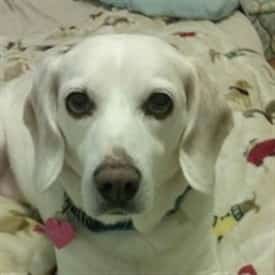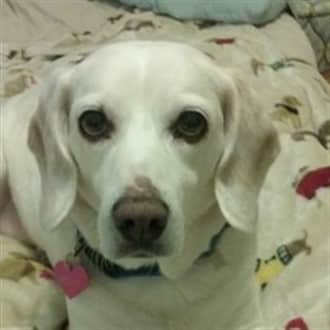When Beagles Chew at or Lick Their Paws
Overview
There are a number of reasons why a Beagle will chew at, bite at, lick, or otherwise pay attention to their paws. In most cases, it stems from an irritation or itchiness. In some cases, stress or anxiety may be the root cause. Unfortunately, the effects of paw chewing or licking can quickly spiral. Continual attention paid to the paws often leads to further irritation including sores and secondary bacterial or yeast infections may develop.
This article will cover the most common reasons a Beagle will lick or chew at their paws including steps to take to help resolve the issue.
Please note:
BeaglePro is reader-supported, and some of the product suggestions on this page are affiliate links. As an Amazon Associate we earn from qualifying purchases. This is at no extra cost to you and helps us keep this site running.
Reason #1: Contact Irritation
What happens:
Anything that a Beagle’s paws comes into contact with can cause a reaction. Some of the top culprits include:
Lawn care products
– Weed killer, fertilizer, and pesticides can all cause itching or irritation. Even if you do not use these products at home, there can be run-off from neighboring yards after a rain or a Beagle can come into contact with these elements at parks and other public places.
Winter-related products
– Rock salt and other related products designed to melt snow and ice often contain sodium chloride or other ingredients that can either cause severe drying or be an irritant to the paws. Traction sand can be very gritty on the paws, causing surface scratches.
Household cleansers
– This includes carpet cleaning solutions and any items such as throw rugs, pillows, etc. that have been washed with laundry detergent containing fragrances or dyes.
What to do:
1)
Try to identify and eliminate the irritant.
2)
Apply paw wax to your Beagle’s paws to offer a barrier to various irritants (see details below under Paw Care Products).
3)
Rinse off your Beagle’s paws after coming inside.
4)
For immediate relief, use an anti-itch spray (see details below under Paw Care Products).
Cuteness break!
Rocky, at 4 and 1/2 years old, photo courtesy of Leigh McCall
Reason #2: Allergies
What happens:
Itching is a top sign of allergies, and while this is often a full-body issue, it is common for a Beagle to mainly chew at the paws since it is an easily accessible body part. This said, you may notice other symptoms such as itching on other areas (a dog may rub his body against surfaces or try to lick or bite other areas), bloodshot eyes, runny eyes, and/or breathing-related issues (coughing, wheezing, sneezing).
Allergies can be year-round or seasonal. Top triggers include pollen, grasses, dust mites, mold, and certain foods.
What to do:
1)
Work to limit or eliminate the trigger. For seasonal grass and pollen allergies, this may include avoiding long walks on high-pollen days, and wiping down the coat with grooming wipes like Earthbath All Natural Grooming Wipes
 and rinsing off paws before coming back inside.
and rinsing off paws before coming back inside.
For many types of airborne allergens including mold, dust mites, and pollens and grasses, using HEPA filters in central air systems can help a great deal. It can also help to vacuum floors with a HEPA vacuum cleaner and use dust mite pillow cases and mattress protectors.
If you suspect food allergies, consider switching formulas; this may involve lower grain counts or a change in the main protein.
2)
For moderate to severe allergies, prescribed medications may be needed including antihistamines and/or anti-inflammatories. Omega-3 fatty acid supplements may also be given.
3)
Use an anti-itch spray on the paws to offer immediate relief (see details below under Paw Care Products).
Cuteness break!
Diego, approximately 1 year old (was rescued),
photo courtesy of Robert and Martha Flores
Reason #3: Yeast Infection on the Paws
What happens:
Yeast that naturally lives on a dog’s skin are triggered to multiply, resulting in what is referred to as an infection. This population explosion of yeast can occur due to a lowered immune system (commonly seen with dogs that are ill or taking certain medications), excessive moisture on the paws (sometimes due to excessive licking that was caused by another issue), or even certain foods (often carbs like potatoes that the body breaks down into sugar or ingredients like fructose syrup or honey).
The top sign that it is a yeast infection causing a Beagle to chew or lick at his paws is a strong, unpleasant odor that some equate to old musty socks, corn chips, or cheese popcorn.
Other symptoms include inflamed nail beds and/or other areas on the paws, thickened or oily skin, flaking or crusty skin, and/or warmth.
What to do: veterinary treatment
1)
If you are not sure if a yeast infection is to blame, this can be confirmed at the vet’s office via a skin scraping that is analyzed under a microscope.
2)
With moderate to severe infections, or for Beagles that have chronic yeast infections on the paws, this may require veterinary treatment that may include oral anti-fungal medications and topical anti-fungal ointment. Any secondary bacterial infections will be treated with antibiotics.
What to do: at-home treatment:
1)
Keep paws dry. After baths, be sure to dry your Beagle’s paws, and don’t forget about in between the toes. If your Beagle’s paws are wet from being outside, rinse and then dry the paws.
2)
Soak the paws in the tub, using a broad-spectrum anti-fungal shampoo. This can be done in conjunction with treating the paws with an anti-fungal topical spray (For both of these, see details below under Paw Care Products).
3)
For chronic issues, a change to a lower-carb diet may be needed. Adding in low-glycemic vegetables to take the place of some carbs can help; this includes sugar snap peas, kale, and butternut squash.
Cuteness break!
Molly, approaching 10 years old (lemon Beagle), photo courtesy of Leslie C.
Reason #4: Dry skin
You may wonder if simple dry skin can be at the root of your Beagle chewing, biting, and licking the paws until they’re raw. However, dry skin can be exceedingly itchy, particularly if this is a chronic problem.
What happens:
It’s common for dry skin to develop during the wintertime
when the air itself is dry. Heating the house never adds any moisture to arid air, in fact, it makes it worse. Dry skin may reach its peak during the spring, once a Beagle has had the issue gradually developing for months.
Alone or in connection with arid air, inadequate water intake and/or subpar shampoos that contain parabens and other harsh ingredients can cause dry skin.
Though this issue can be body-wide, it often manifests on the paws due to a combination of friction from walking surfaces exacerbating the problem and the fact that the paws are so accessible for chewing and licking.
What to do:
1)
In the winter, consider using a humidifier to add crucial moisture back into the air in your home, aiming for a humidity level between 25 to 40%. Ideally, you will want to have enough to cover the square footage of your home; but, at minimum, place one like the MistAire Ultrasonic Cool Mist Humidifier
 near your Beagle’s sleeping area.
near your Beagle’s sleeping area.
2)
Be sure that your Beagle is drinking enough water. Canines need from 1/2 to 1 ounce of water for each pound of body weight; this varies depending on a dog’s activity level. It never hurts to aim for the high end, as long as your Beagle drinks their water slowly.
3)
Treat the paws with a healing cream to moisturize and heal dry paw skin (see details below under Paw Care Products).
4)
Once paws have been restored back to health, regularly apply a paw wax to provide a layer of protection and keep paws properly moisturized (see details below under Paw Care Products).
Cuteness break!
Misha, at 5 months old, photo courtesy of Danijel
Reason #5: Other less common but possible causes
Though these issues are seen far less often with Beagles, all are possible causes of severe and compulsive paw licking and/or chewing.
Parasites
– Though mites and fleas are usually a full-body issue, this can start on the paws. Ticks, on the other hand, are localized and would often involve just one paw.
With mites, there is usually hair loss, inflammation, and oily skin; this often will progress from the paws over to other areas of the body. And, though nearly microscopic, mites may be visible on close inspection. Mites diagnosed via a skin scraping and treated with topical anti-parasitic medications.
With fleas, there is severe itching, often quickly spreading to other parts of the body. It’s not easy to see fleas since they are super-fast and jump out of the way when hair is parted, but their droppings (tiny black spots) may be visible. Treatment for fleas must involve both topical treatment for a dog and treating the house.
Ticks
bury their head into the skin, but the body will be seen. Depending on the type of tick and how much blood it has ingested, these can range in size from 1/8 to 1/2 long. Ticks should be removed asap; it usually takes 36 to 48 hours for disease, including Lyme disease, to be transmitted.
Stress/boredom
– Often seen with Beagles that have severe separation anxiety, dogs that are extremely stressed or suffering from isolation may chew or lick their paws as a self-soothing method.
If steps such as offering ‘stay busy’ toys, playing music or leaving on certain TV shows, and having a dog walker break up the day, etc. are not working, prescribed anti-anxiety medication may be needed.
Acute pain
– Anything that could cause discomfort can cause a Beagle to lick the paws. This includes burns from hot walking surfaces and scrapes or lacerations.
Minor burns to the paws can be treated at home with a healing cream, but moderate to severe burns must be treated at the vet clinic. Minor to moderate lacerations may be able to be treated at home by rinsing the area, applying an antibiotic gel, and a wrapping the paw.
Acral lick granulomas
– What started with one thing (dry skin, irritation, licking due to stress.) can spiral into this much more severe issue of lick granulomas in which compulsive licking has caused thickened skin, oozing sores, and damaged hair follicles. Treating this can be tricky and often involves treatment for the wound, methods to prevent licking (like safety collars or paw wraps), antibiotics, and sometimes laser surgery.
Cuteness break!
Bailey, at 4 years old, photo courtesy of Lorraine Lepkowski
Paw Care Products
Hopefully, you have now been able to identity the root cause of your Beagle biting or licking at the paws and can move on to offering relief from itching or irritation via a topical treatment. But, even if you are still stumped, there are some products that can help. Let’s take a look.
Paw wax
Paw wax has a great many benefits and this should be applied to a Beagle’s paws year-round. One like Mushers Secret Pet Paw Protection Wax
 will offer a breathable layer of protection from both hot and cold walking surfaces, help repel irritants, provide better traction, and keep paw skin properly moisturized.
will offer a breathable layer of protection from both hot and cold walking surfaces, help repel irritants, provide better traction, and keep paw skin properly moisturized.
Anti-itch spray for the paws
There are two options for this, all-natural and medicated.
An all-natural spray should not be discounted. One like Bodhi Dog Anti-Itch Spray
 has both baking soda and oatmeal which are two very effective ingredients that stop itching and help resolve inflammation. This can be applied 3 to 4 times per day and make sure that the last application is right before your Beagle goes to sleep.
has both baking soda and oatmeal which are two very effective ingredients that stop itching and help resolve inflammation. This can be applied 3 to 4 times per day and make sure that the last application is right before your Beagle goes to sleep.
If your Beagle is chewing and licking at the paws like crazy and is in obvious severe discomfort, you may wish to opt for a medicated spray. One like SynergyLabs Veterinary Formula Medicated Spray
 has hydrocortisone to stop itching and lidocaine which is a numbing agent to help with discomfort. Note that with this, you will want to prevent your Beagle from licking the paws, using a wrap or cone collar (recommendations ahead).
has hydrocortisone to stop itching and lidocaine which is a numbing agent to help with discomfort. Note that with this, you will want to prevent your Beagle from licking the paws, using a wrap or cone collar (recommendations ahead).
Healing cream
For sores, cuts, burns, severe dry paw skin, peeling, or cracking, you’ll want to soothe and restore the paws. For this, ResQ Organics Pet Skin Treatment
 is recommended. This has an amazing blend of aloe vera, Manuka honey, coconut oil, olive oil, hemp seed oil, shea butter, and vitamins to offer fast relief and promote healing.
is recommended. This has an amazing blend of aloe vera, Manuka honey, coconut oil, olive oil, hemp seed oil, shea butter, and vitamins to offer fast relief and promote healing.
Massage this into the paws 3 times per day, with the last application at night right when your Beagle is getting ready to go to sleep.
Yeast infection treatments
For this, broad-spectrum anti-fungal products are recommended.
If you will be working to treat your Beagle’s paw yeast infection at home, it’s important to soak the paws, which will allow the medication to penetrate the nail beds and crevices of the paws.
Since most Beagles will not sit still for a foot soak, this is best done in the bathtub. Fill the tub with several inches of water, add in 1/4 to 1/2 cup of a medicated shampoo like Curaseb Antifungal & Antibacterial Shampoo
 that contains chlorhexidine and ketoconazole, and stir the water. Then, place your Beagle in the bath and allow the paws to soak for 10 minutes. Drain the tub and rinse the paws. Pat the paws to dry them since rubbing may cause discomfort.
that contains chlorhexidine and ketoconazole, and stir the water. Then, place your Beagle in the bath and allow the paws to soak for 10 minutes. Drain the tub and rinse the paws. Pat the paws to dry them since rubbing may cause discomfort.
In combination with this, the paws can be sprayed with a topical spray like Curaseb Anti-Itch Anti-Fungal Spray
 up to 3 times per day; but, do note that a paw wrap or cone collar should be used to prevent your Beagle from licking this product.
up to 3 times per day; but, do note that a paw wrap or cone collar should be used to prevent your Beagle from licking this product.
If you do not see improvement after two weeks, the yeast infection may be stubborn and require prescribed oral anti-fungal medication
Paw wraps to prevent chewing and licking
If you need to bandage a paw or wrap it to stop your Beagle from biting, chewing, or licking the paw, PawFlex Paw Bandages for Dogs
 is a great choice. There are 7 sizes, ranging from triple-extra-small to extra-large. These are breathable, durable, and have Velcro fasteners around the ankle for a secure and comfortable fit.
is a great choice. There are 7 sizes, ranging from triple-extra-small to extra-large. These are breathable, durable, and have Velcro fasteners around the ankle for a secure and comfortable fit.
Cone Collar to prevent paw chewing
While no one looks forward to doing this, in some circumstances, it is best for a Beagle to have a cone collar to prevent the paws from being licked or chewed while itch relief is applied and steps are being taken to treat the underlying cause.
For this, The Original Comfy Cone by All Four Paws
 is a good option. This is made with foam-padded nylon and adjustable Velcro closures. An added plus is that this is water resistant.
is a good option. This is made with foam-padded nylon and adjustable Velcro closures. An added plus is that this is water resistant.
Cuteness break!
Bella, at 6 months old, photo courtesy of Anita Malan
A Final Word
The paws are right there, so easy for a Beagle to chew at. And, it doesn’t take much, just a small itch or tiny discomfort can set a puppy or dog off to bite, gnaw, or lick. If the paws are really itchy, a Beagle can lick or chew the paws nearly raw. But, who can blame them? It’s almost impossible to ignore an itch.
As soon as you notice your Beagle paying attention to the paws, take steps to try and identify the reason. Offer help via anti-itch sprays and do not hesitate to bring your Beagle to the vet to either diagnose the cause or to learn about options for prescribed treatments.
Other Helpful Articles:
How to stop a Beagle from eating feces
- This is a bad habit that is not uncommon with dogs. Learn the top reasons why dogs do this and exact steps to stop this asap.
Stopping a Beagle with aggressive chewing issues
- If your Beagle is ripping the house apart, help is here with these top tips.
Beagle house training tips
- Whether you have a new pup that needs to learn it all or an adult that could use a bit of fine tuning, these guidelines will help you find fast success.












